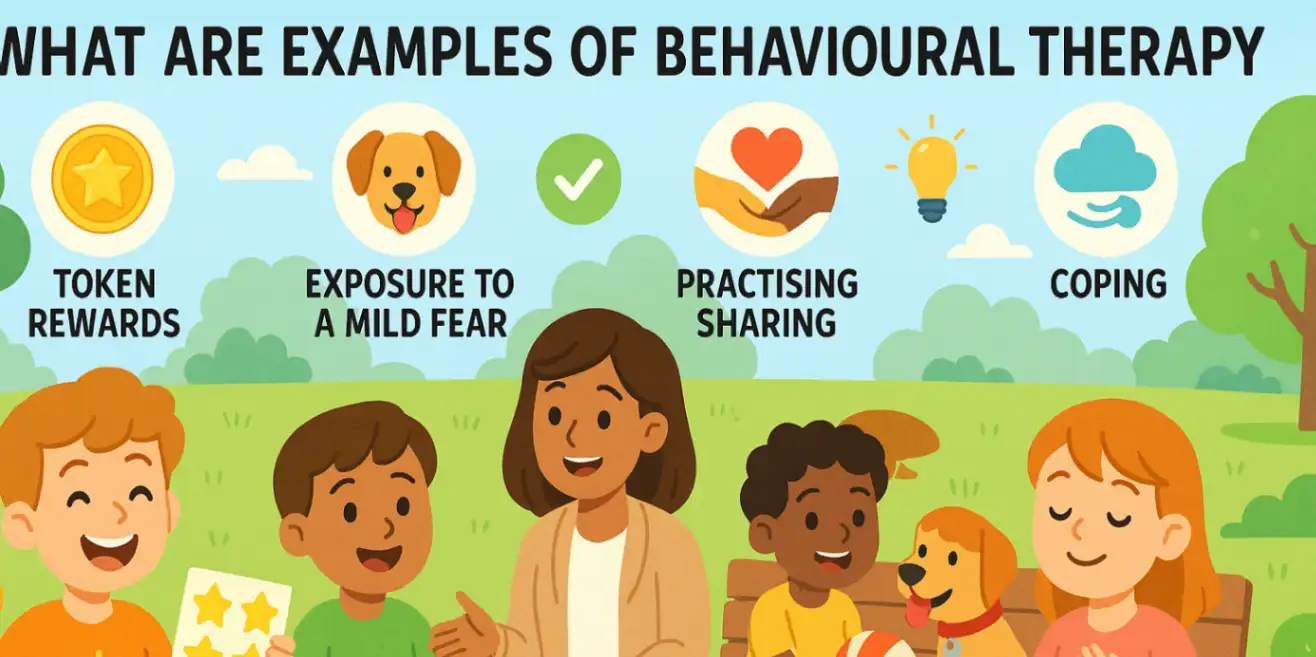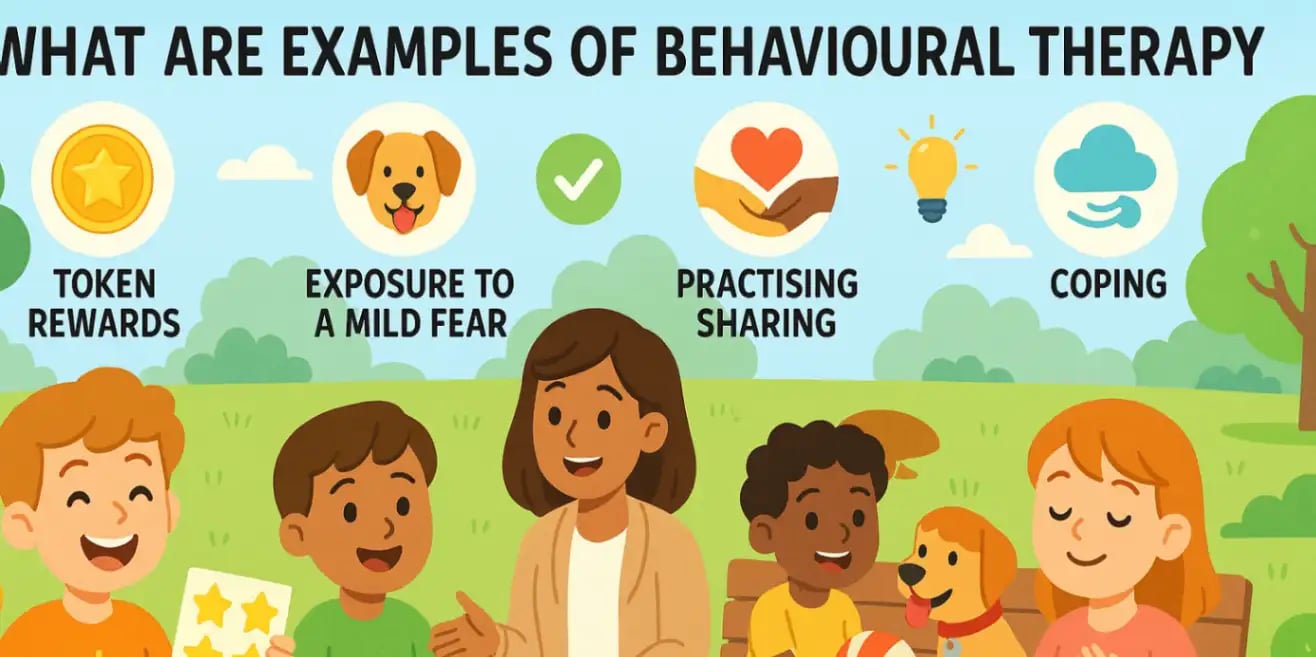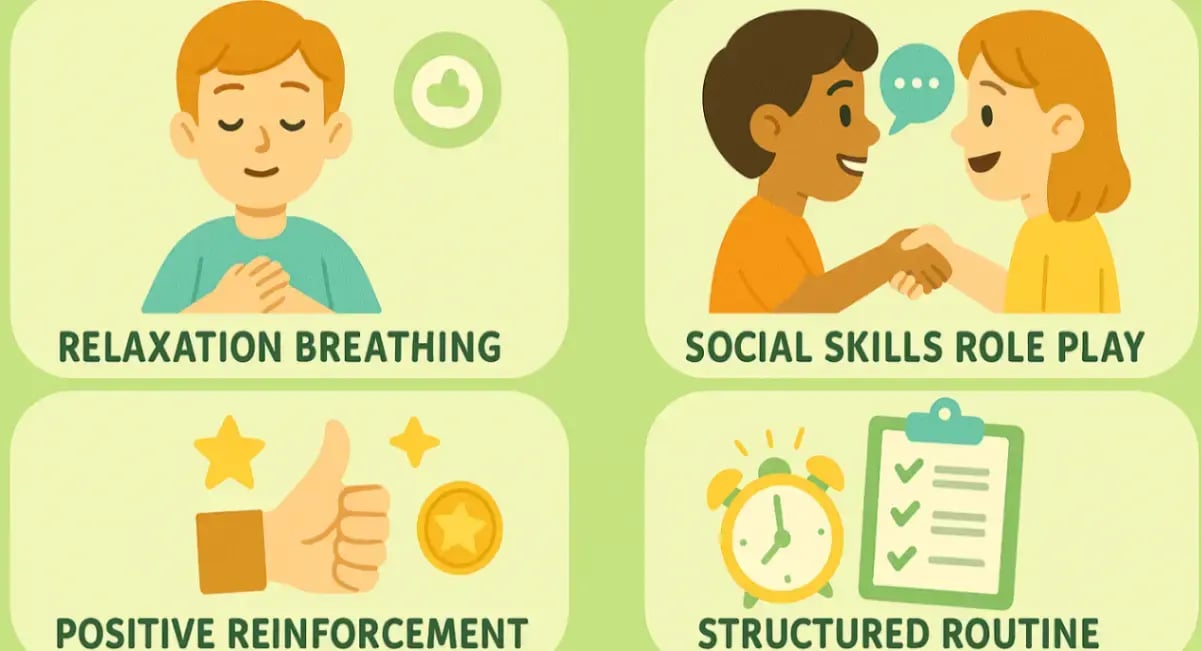
examples of behavioural therapy techniques
10 October, 2025
Introduction
Are you looking for practical ways to manage your mental health and change unhelpful habits? Unlike therapies that focus on childhood experiences, behavioral therapy is an action-oriented approach centered on your current problems. This type of therapy provides you with tangible skills to address issues like anxiety disorders or phobias. The core idea of behavior therapy is that since behaviors are learned, they can also be unlearned, empowering you to make positive changes in your life.
Key Highlights
-
Behavioral therapy is an action-based approach focused on changing negative behaviors to improve your mental health.
-
Key behavioral therapy techniques include positive reinforcement, systematic desensitization, and modeling.
-
One of the most common types is cognitive behavioral therapy (CBT), which targets the connection between your thoughts and actions.
-
This type of therapy offers evidence-based benefits for treating various conditions, including anxiety disorders, phobias, and depression.
-
The goal is to unlearn problematic behaviors and develop healthier coping skills for a better quality of life.
Understanding Behavioral Therapy

Behavioral therapy is a broad term for treatments that help you identify and change potentially self-destructive or problematic behaviors. It operates on the principle that all behaviors are learned and that you can learn new, healthier ones.
These behavioral approaches are highly focused and designed to produce results efficiently. Instead of spending extensive time on the past, you and your therapist will work on strategies to address current issues, from managing stress to overcoming specific fears. Next, we’ll explore what this looks like in more detail.
Defining Behavioural Therapy
At its heart, behavioral therapy is a type of therapy grounded in the principles of behaviorism. This school of thought emphasizes that our environment shapes how we act. The central idea is that if old learning led to a problem, new learning can fix it. It's a very direct and practical approach to mental wellness.
This form of therapy is action-based. This means the behavior itself is seen as the problem, and the main goal is to teach you new behaviors to eliminate or minimize the issue. It's not about deep insight into your past but about making concrete changes now.
Because of this focus, behavioral therapy is used to treat a wide array of mental health conditions. It provides structured, goal-oriented treatment for everything from anxiety and phobias to substance use disorders, helping you build a healthier future.
How Behavioural Therapy Works in Practice
So, what does behavior therapy look like during a session? Your journey will start with building a trusting relationship with your mental health professional. This partnership is essential, as you'll work together to identify the problematic behaviors you want to change and set clear, achievable goals.
In clinical practice, your therapist will guide you through various exercises. For example, you might use journaling to track your moods and identify triggers for unwanted actions. Role-playing is another common tool, allowing you to practice new social skills or ways of reacting to situations in a safe space.
Your therapist will regularly check in on your progress and may adjust the treatment plan as you go. The process is collaborative and requires your active participation. You'll learn relaxation techniques and other skills to manage emotional reactions, empowering you to handle challenges more effectively outside of therapy.
Key Principles of Behavioural Therapy

The foundation of behavioral therapy rests on two key learning theories: classical conditioning and operant conditioning. Classical conditioning, famously studied by Ivan Pavlov, involves forming associations between stimuli. In therapy, this might mean unlearning a fear response that has become associated with a harmless object or situation. It's about changing the automatic reactions that contribute to negative behavioral patterns.
Operant conditioning, on the other hand, focuses on how consequences shape behavior. This principle uses reinforcement (rewards) to increase the frequency of desirable behaviors and punishment to decrease unwanted ones. Behaviour therapy techniques are built on these ideas, aiming to reinforce positive actions and extinguish negative ones. By understanding these principles, you can see how therapy provides a structured way to reshape your habits and reactions.
Main Types of Behavioural Therapy
Behavioral therapy is not a single, one-size-fits-all approach. It's a category that includes several different types of therapy. The specific type of psychotherapy your therapist recommends will depend on your unique needs, the condition being treated, and the severity of your symptoms.
Each type uses different methods to help you change your behavioral patterns. From focusing on thoughts to confronting fears, these therapies offer diverse paths to the same goal: better mental health. Let's look at some of the most common types used today.
Cognitive Behavioural Therapy (CBT)
Cognitive behavioral therapy, or CBT, is one of the most popular and well-researched forms of therapy. It differs from other behavioral therapies by adding a crucial cognitive element. CBT operates on the idea that your thoughts, feelings, and behaviors are interconnected, and that negative thought patterns can lead to unwanted actions.
The goal of this cognitive therapy is to help you identify and challenge these problematic thoughts. Through a process called cognitive restructuring, you learn to replace negative or irrational beliefs with more realistic and positive ones. This shift in thinking naturally leads to a change in behavior.
CBT is considered a "gold standard" for the treatment of depression, anxiety, anger issues, and more. It's often a short-term treatment, with many people seeing significant progress in just 5 to 20 sessions, making it an effective and affordable option for many.
Dialectical Behaviour Therapy (DBT)
Dialectical behavior therapy (DBT) is a specific form of CBT originally developed to treat borderline personality disorder (BPD). While it shares roots with CBT, DBT is different because it places a strong emphasis on acceptance and emotion regulation. It blends traditional cognitive and behavioral techniques with mindfulness practices.
The core of DBT involves balancing acceptance (accepting yourself and your current situation) with change (working to build a better life). This "dialectic" helps people who experience intense emotions learn to manage them without judgment. It teaches skills in four key areas: mindfulness, distress tolerance, emotion regulation, and interpersonal effectiveness.
While highly effective for BPD, DBT is also used to treat a range of other conditions. These include substance use disorder, eating disorders, and even chronic pain. By teaching practical coping skills, DBT helps individuals handle distressing situations and improve their relationships.
Acceptance and Commitment Therapy (ACT)
Acceptance and commitment therapy (ACT) offers a unique perspective compared to other behavioral therapies. Instead of trying to eliminate difficult thoughts and feelings, ACT teaches you to accept them as a natural part of life. The idea is that struggling against or avoiding pain often makes it worse.
This form of commitment therapy encourages you to confront your struggles without judgment. The focus is on increasing psychological flexibility—the ability to be present with what life brings and move toward valued behavior. You'll work to clarify your core beliefs and values, which then guide your actions.
ACT is used for various mental health conditions, including anxiety and depression. The goal isn't to feel good all the time but to live a rich, meaningful life despite inevitable challenges. You learn to unhook from unhelpful behavioral patterns and commit to actions that align with what truly matters to you.
Exposure Therapy
Exposure therapy is a powerful technique designed to help you confront your fears. When you have an anxiety disorder, a phobia, or a panic disorder, your natural instinct is to avoid the things that scare you. However, this avoidance often makes the fear grow stronger over time.
This therapy provides a safe, controlled environment to face your fears head-on. The process is gradual and managed by a therapist to ensure you feel secure. A common method used within exposure therapy is systematic desensitization, where you slowly work your way up a "fear ladder."
For example, if you have a fear of flying, you might start by looking at pictures of planes, then watching videos, visiting an airport, and eventually taking a short flight. Paired with relaxation techniques, this gradual exposure helps you "unlearn" the fear response, reducing anxiety and panic.
Applied Behaviour Analysis (ABA)
Applied behavior analysis (ABA) is a type of therapy that uses the principles of operant conditioning to bring about meaningful and positive change in behavior. It focuses on understanding how behavior works, how it's affected by the environment, and how learning takes place.
ABA is most widely known as a treatment for autism spectrum disorder. In this context, therapists use it to help individuals develop social skills, communication abilities, and daily living skills. The approach involves breaking down complex skills into small, manageable steps and reinforcing progress along the way.
However, its applications extend beyond autism. ABA is also used to address problematic behaviors in children with developmental disabilities and can even be applied in settings like special education and elder care. It is a highly structured and data-driven approach to modifying behavior.
Common Behavioural Therapy Techniques
Now that you know about the main types of therapy, let's explore some of the specific tools therapists use. These behavioral therapy techniques are the building blocks of treatment, designed to help you change maladaptive behaviors and learn new ways of responding to situations.
Many of these behavioral approaches are used across different types of therapy, including cognitive behavioral therapy. They are practical, hands-on methods that you can learn and apply in your daily life. Here are a few of the most common techniques.
Positive Reinforcement
One of the most fundamental behavioral therapy techniques is positive reinforcement. Based on the theory of operant conditioning, this strategy involves rewarding a desired behavior to make it more likely to happen again. It's a simple yet powerful tool for shaping behavior.
In behavior therapy, reinforcement must be meaningful to the individual. What works for one person may not work for another. The key is to provide a positive consequence immediately after the desired action occurs, strengthening the connection between the action and the reward.
This technique is used in many settings, from parenting to therapy. Here are some examples:
-
A child receives praise from a parent for cleaning their room.
-
An employee gets a bonus for meeting a sales target.
-
In therapy, a client might reward themselves with a relaxing activity after successfully using a new coping skill.
Systematic Desensitization
Systematic desensitization is a classic technique often used in exposure therapy to treat anxiety disorders, phobias, and panic disorder. It works by gradually exposing you to your fear while you are in a state of relaxation, which helps weaken the fear response over time.
Finally, you begin to confront your fears. While in a relaxed state, you'll start with the least fear-inducing item on your list and slowly work your way up. Key steps include:
-
Learning relaxation skills like deep breathing.
-
Creating a ranked list of your fears (e.g., from seeing a spider in a photo to holding one).
-
Confronting each item on the list while practicing relaxation until the anxiety subsides.
Token Economies
Token economies are a structured form of positive reinforcement used to modify behavior. In this system, individuals earn "tokens" for engaging in specific desired behaviors. These tokens, which can be chips, stickers, or points, act as a secondary reinforcer because they can be exchanged for meaningful rewards.
This technique is often used by parents and teachers, and it's also a tool in behavior analysis for addressing problematic behaviors. The system is very clear: you know exactly what you need to do to earn a reward. It can also be designed so that tokens are lost for undesirable behaviors.
The effectiveness of token economies comes from the immediate feedback and reward. Examples of how it works include:
-
Children earning stickers for good behavior, which can be traded for toys or extra playtime.
-
Patients in a psychiatric facility earning points for attending group therapy, which they can exchange for special privileges.
Role Playing and Social Skills Training
Improving social skills is a common goal in behavioral therapy. Role-playing and social skills training provide a safe and supportive space to practice interactions that you might find difficult in real life. This technique is excellent for improving interpersonal relationships and building confidence.
During a session, you might act out a specific scenario with your therapist, such as asking for a raise, resolving a conflict with a friend, or going on a first date. Your therapist can provide feedback and modeling, showing you different ways to handle the situation.
This hands-on practice helps you prepare for real-world challenges. The main goals of this training are:
-
Learning and rehearsing new behaviors in a controlled setting.
-
Receiving immediate feedback on your performance.
-
Building confidence to use new social skills outside of therapy.
Modeling and Imitation Therapy
Modeling is a behavioral therapy technique based on Albert Bandura's social learning theory, which states that people learn by observing others. In therapy, this means you learn new skills and acceptable behaviors by watching someone else—often the therapist or peers in a group setting—perform them successfully.
Rather than relying solely on instruction or reinforcement, modeling allows you to see the desired behavior in action. This can be particularly helpful for learning complex social skills or new ways of coping with challenging situations. The therapist acts as a role model, demonstrating healthy responses.
This is one of the most intuitive behavioral approaches. The process helps you:
-
Observe appropriate behaviors in a specific context.
-
Imitate the modeled behavior in a safe environment.
-
Receive encouragement and feedback to refine your new skills.
Effectiveness of Behavioural Therapy
You might be wondering, does behavioral therapy actually work? The answer is a resounding yes. Its effectiveness is backed by extensive research, and it has been shown to provide significant evidence-based benefits for a wide range of mental health conditions. Cognitive behavioral therapy (CBT) in particular is often called the "gold standard" in psychotherapy for its proven results. Research shows that about two-thirds of people who try psychotherapy experience positive improvements.
The targeted, action-oriented nature of these therapies means that many people see results in a relatively short amount of time. It is especially effective for anxiety disorders, including PTSD, panic disorder, and OCD, as well as for depression and stress management.
|
Condition |
Effectiveness of Behavioral Therapy |
|---|---|
|
Anxiety Disorders |
Highly effective, especially with exposure therapy and CBT. |
|
Depression |
CBT is a "gold standard" treatment, often combined with medication. |
|
Phobias |
Systematic desensitization and exposure therapy show excellent results. |
|
Substance Use Disorders |
Can be effective, though success may vary by substance. |
|
ADHD |
Helps in managing behaviors, often used with medication. |
Evidence-Based Benefits for Mental Health Conditions
The evidence-based benefits of behavioral therapy are well-documented. For many mental health conditions, such as anxiety and depression, approaches like CBT are among the most effective treatments available. They directly address current problems, helping you develop healthier thought patterns and coping strategies.
By focusing on tangible skills, this therapy empowers you to manage your symptoms actively. Instead of just talking about problems, you're learning how to solve them. This can lead to improved communication, better stress management, and higher self-esteem.
Ultimately, the goal is to improve your overall quality of life. Research has shown that these therapies not only reduce symptoms but also help prevent relapse. By equipping you with tools to handle challenges, behavioral therapy provides lasting benefits that extend far beyond the therapist's office.
Suitability for Different Age Groups and Populations
One of the great strengths of behavioral therapy is its suitability for a wide variety of age groups and populations. The techniques are flexible and can be adapted by mental health professionals to meet the developmental needs of different individuals, from young children to older adults.
For children, therapists often use modified behavioral therapy techniques. For example, cognitive behavioral play therapy uses play to help a child learn how to think and behave differently. Techniques like token economies and modeling are also highly effective in pediatric settings.
For adults and teenagers, the therapy can be tailored to address specific life challenges, whether it's managing workplace stress, navigating relationship issues, or overcoming a substance use disorder. This adaptability makes behavioral therapy a versatile and valuable tool for almost anyone seeking to make a positive change.
How to Start Behavioural Therapy in Australia
If you feel that behavioral therapy could be right for you, taking the first step is often the biggest hurdle. Starting the process involves finding qualified mental health professionals who can provide these specialized health services. Finding the right therapist—someone you trust and feel comfortable with—is crucial for the treatment to be effective.
Your journey toward better mental health is a collaborative one, and it begins with connecting to the proper support system. Navigating the health care system can feel overwhelming, but there are clear steps you can take to find a professional who can guide you. Below are some tips on how to find a therapist and what to expect.
Steps to Finding a Behavioural Therapist
Finding the right therapist for behavioral therapy may seem daunting, but it can be a straightforward process. You'll want to look for licensed mental health professionals, such as psychologists, counselors, psychiatrists, or clinical social workers, who specialize in behavioral approaches.
A great place to start is by asking for a recommendation. Your primary care physician can often provide a referral to trusted local professionals. You can also contact your health insurance provider to get a list of covered therapists and find out how many sessions your plan includes.
Once you have a list of potential therapists, take some time to research them. Many have websites that describe their approach and specialties. To find the right fit, consider these steps:
-
Ask your doctor for a referral.
-
Contact your insurance company for a list of in-network health services.
-
Use online directories from professional organizations.
-
Schedule an initial consultation to see if you connect with the therapist.
What to Expect During the First Session
Your first session of behavioral therapy is primarily an assessment and an opportunity for you and your therapist to get to know each other. Don't worry about having to dive into your deepest fears right away. The main goal is to establish a trusting relationship and discuss what brought you to therapy.
Your therapist will ask you about your current struggles, your history, and your goals for treatment. This conversation helps them understand your situation and begin formulating an effective treatment plan. Being open and honest is key to making the most of your sessions.
The first session is a chance for you to see if the therapist is a good fit. Here’s what you can generally expect:
-
Discussing your symptoms and what you hope to achieve.
-
Answering questions about your mental and physical health history.
-
Collaborating with the therapist to set initial goals.
-
Learning about the therapeutic process and what to expect in future sessions.
Conclusion
In summary, behavioral therapy offers a diverse range of techniques that can significantly improve mental well-being. Through methods such as positive reinforcement, systematic desensitization, and role-playing, individuals can learn to manage their thoughts, emotions, and behaviors effectively. The adaptability of these techniques makes them suitable for various age groups and mental health conditions.
From positive reinforcement to emotional regulation, behavioural therapy helps children develop healthy coping skills and everyday confidence. Our caring team at daar tailors each approach to your child’s unique needs. Book your consultation now.
Frequently Asked Questions
Is behavioural therapy effective for depression and anxiety?
Yes, behavioral therapy is highly effective for both depression and anxiety disorders. Cognitive behavioral therapy (CBT), in particular, is considered a "gold standard" treatment. Its proven effectiveness comes from teaching practical skills to manage symptoms, challenge negative thoughts, and change behaviors, leading to lasting improvement.
Can children benefit from behavioral therapy?
Absolutely. Children can greatly benefit from behavioral therapy. Mental health professionals adapt behavioral therapy techniques to be age-appropriate, using methods like play therapy and token economies. These types of behavioral therapy help children develop social skills, manage emotions, and address behavioral issues in a supportive environment.
How does cognitive behavioural therapy differ from other behavioural therapies?
Cognitive behavioral therapy (CBT) differs from other types of therapy by adding a cognitive element. While traditional behavioral therapy focuses solely on changing behaviors, CBT also targets the underlying thoughts and core beliefs that drive those behaviors. This cognitive therapy component helps you understand the connection between how you think and how you act.
.svg)












